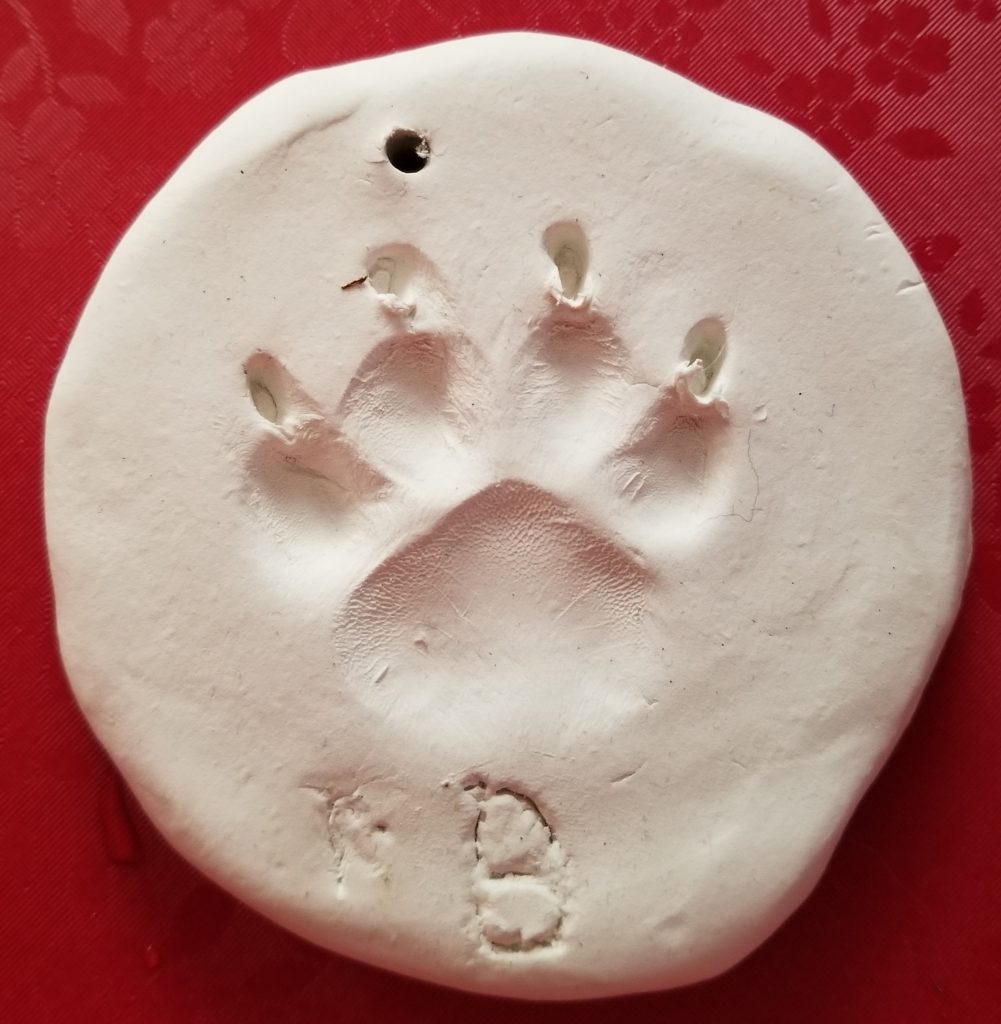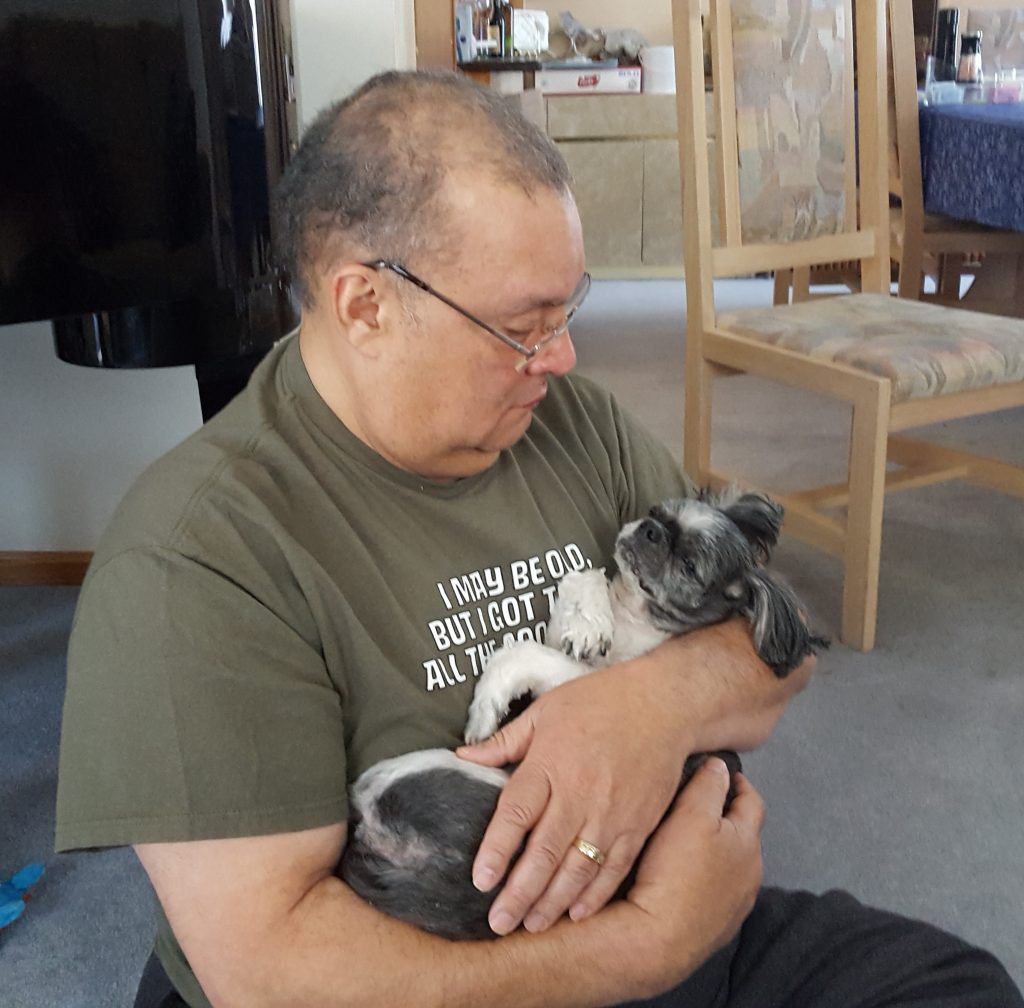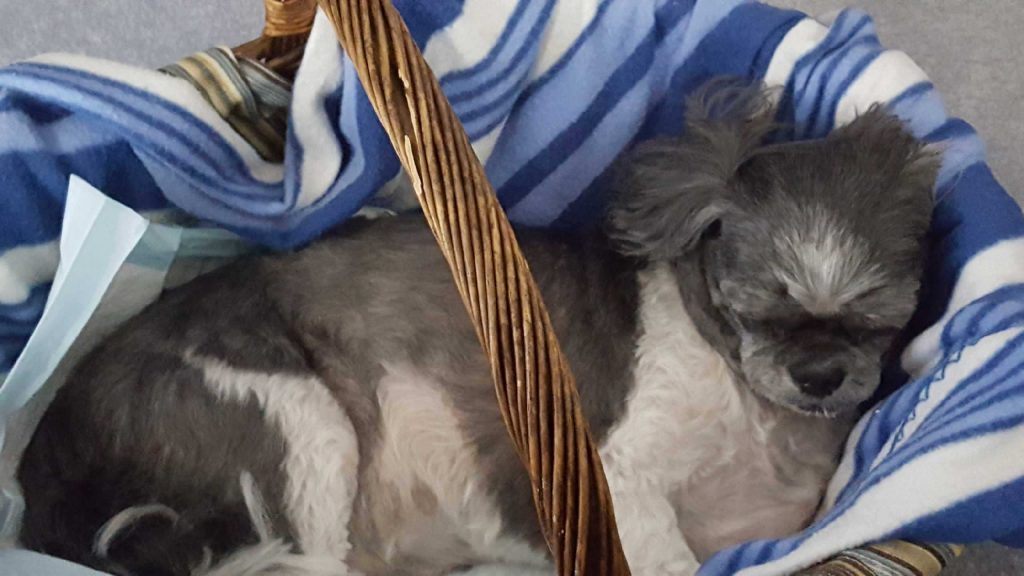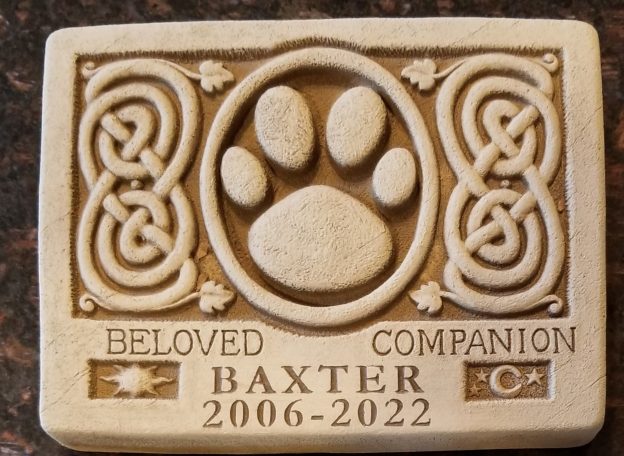Several years ago we suspected Baxter had become diabetic and had a bladder infection. He was drinking even more water than he normally would during the summer, and he urinated large quantities more frequently. We took him to Dr. Laura, our veterinarian, with our concerns.
“Normally I’d question someone else’s diagnosis but you two are pretty astute and you’re probably right.”
His blood sugar was 600 and he did indeed have a bladder infection. Dogs usually do not develop Type 2 diabetes; their pancreatic islet cells just shut down completely. Insulin remains the only treatment but titrating the dose required a few all-day suckers for glucose curves. Baxter used to love going to see Dr. Laura but, after three glucose curves over a few months, he associated the veterinarian’s office with things unpleasant and traumatic.
Baxter did really well for the next few years. He adjusted to the insulin quickly after Peg promised him two training treats after each injection. His appetite was never a problem. I started taking him to a local park for his afternoon walk after he went berserk over the neighbors’ dog behind the fence and got a terrible neck muscle strain yanking on his leash. He developed a cataract in his right eye; diabetes and age would eventually take its toll on the rest of his vision. But he still appeared to be one happy (and demanding) puppy.
Dr. Laura discovered a lesion in Baxter’s mouth in May 2021 when he went in for his heartworm test.
“He’s got this black thing on his upper gum that wasn’t there a few months ago when we saw him for his dental, and I’m afraid it might be melanoma. It’s the most common location in dogs because of the hyperpigmentation of their oral mucosa. I want to get him in to remove it as soon as possible; then we’ll just wait for the pathology report.”
A week later she told us it was indeed canine melanoma, but with a low mitotic rate, giving us some hope, even though the lesion had appeared rather quickly. She suggested a consultation with the local veterinary oncology group so we made an appointment.
We were still in the middle of the COVID-19 pandemic so we sat in the car in the heat while one of the vet techs took Baxter inside for evaluation. The veterinary consultant came out to talk with us after about 45 minutes. She was young, sweet and well-meaning but lacked the pragmatism that comes with experience.
“If we don’t do anything, you can expect him to live about three to six months. We can do surgery to remove part of his jaw treat him with radiation, once a week for 6 weeks after he’s healed from the surgery. We’d have to sedate him every time he has radiation. That might give him more time, probably six to twelve months. Since he is diabetic, though, it’s important to keep him on a strict diet and feed him every 12 hours. He shouldn’t have any treats or people food.”
Peg and I glanced at each other. I imagined Baxter rolled his eyes and said, “Well, that ain’t gonna happen,” under his breath.
We thanked her and then talked it over with Dr. Laura.
“He’s fifteen years old and I can’t see putting him through such misery at his age. We can see him every six weeks to follow the tumor’s progress. If he stops eating or appears to be in pain, we can talk about what to do then.”
We agreed and took him home, hoping he would last at least until Christmas. The tumor slowly reappeared but it didn’t seem to bother him. Christmas came and went and when Baxter went in for his annual heartworm test in May 2022 and appeared to still be relatively healthy, Dr. Laura felt that he was more likely to die of something other than the melanoma, so she asked to see him in three months.
By the summer he was definitely slowing down. He spent most of the day sleeping, but he was lively when awake. His appetite was good and he still insisted on his bedtime Pill Pockets. (We joked about “opening another dime bag,” because they were running about eight bucks apiece.) His vision continued to deteriorate; he knew where his water bowl was and I had to guide him to his breakfast and dinner. Sometimes he would get stuck in a corner or beneath the dining room table and we’d have to coax him out.
He could usually make it up the stairs but he was reluctant to go down on his own because his vision was so poor (he’d tumbled down more than once). So he would call for his faithful manservant. I’d hear his collar jingle as he shook himself, then a low growl. If I was too slow to respond, he’s start barking with the classic Shih-Tzu “arf-arf.” (Translation: “It is so hard to find good help these days. I don’t know why I haven’t fired you!”)
I’d climb the stairs and kneel short of the top so we were face to face. I’d scratch his ears while he rubbed his head against me, then work my way back to a butt scratch and tummy rub. He’d wag his tail though not as furiously as when he was younger. I’d always ask for a kiss but he was notoriously stingy, only kissing early in the morning on rare occastion before he remembered he was a tough guy. “No kiss for you!”
Around August Baxter started sleeping poorly at night. He’d usually get up around 2:30am and I’d take him outside; some nights he got up every two hours. That I was retired and could nap during the day made it a lot easier.
By early October he often appeared dazed after his nap, as if he didn’t know where he was or what he wanted to do – doggy senior moments. When he peed by Peg’s desk chair, completely unaware, we pondered that which we’d been avoiding. Maybe it was getting close to his time.
I noticed his tongue flicking in and out when I went upstairs to get him for dinner on Wednesday. On Thursday he started shaking his head as if he had a Parkinson’s tremor. I took a couple of videos on my phone and showed them to Dr. Laura.
“That definitely looks like seizures. Once that starts to happen…”
Peg and I had long ago decided that we wanted him put down at home, especially since he’d become terrified of the vet’s office. Dr. Laura’s practice had become very busy because of COVID and her colleagues, like those of other practices, were stretched thin and she wouldn’t be able to come on short notice. But, she said, there were veterinarians whose sole purpose is providing our companions with the “death with dignity” humans are often denied. The Companion Animal Euthanasia Training Academy (CAETA) certifies practitioners in compassionate and painless in-home euthanasia, minimizing the stress for both the pet and their parents.
Baxter had a major seizure Friday morning about 2:00am and he was terrified. I took him downstairs and outside, but he didn’t need to pee. He just whimpered and shook. I lay down with him in the family room for the next half hour trying to calm him down, then took him back upstairs. He had another seizure around 4:00am but this time he seemed oblivious for which I was thankful.
Peg started calling practices. The first one was a group of three veterinarians but two were out with illness and the woman Peg spoke with said she couldn’t do anything until Monday. She then called Compassionate Heart and spoke with a wonderful woman who said she would be at ou
We felt at ease with Dr. Jessica as soon as we met. We sat in the living room while she talked about her professional history and making the transition from veterinary practice to doing exclusively palliative pet care and in-home euthanasia. She is certified by Fear Free®, an organization whose “mission is to prevent and alleviate fear, anxiety & stress in pets by inspiring and educating the people who care for them” and outlined the procedure.
“We strive to make this as stress-free as possible for him and for you. I usually start with a narcotic and sedative, but the sedative might induce a seizure, so I’ll just use the narcotic. As soon as he’s relaxed I’ll put in the IV catheter and I’ll use a topical anesthetic to minimize any pain. After that, I’ll give him Propofol to make him sleep. When you’re ready I’ll give him last injection, pentobarbital, and he will finally be free of pain.”
“How do you do this? I’ve had to deliver dead babies and it was NEVER easy.”
“People ask me that a lot. I had to put my own dog down a couple of months ago, but doing it at home in familiar surroundings is much less stressful than in a veterinary office. You’re alleviating their suffering and that’s what matters.”
Dr. Jessica went over cremation options. Memorial cremation is done with other pets so the cremains are not separate. A private cremation is done alone and costs more, but the cremains are exclusively those of your pet. The funeral home she used was a family business and “very meticulous.” She would transport him to the funeral home; they would call her in about a week to pick up the urn and she would deliver it to us.
I carried Baxter downstairs and laid him on the blanket she’d provided. She introduced herself to him, speaking softly while stroking his head and getting acquainted. The night had left him exhausted but he leaned into her hand as if she was an old friend.
We started feeding him the beloved Pill Pockets as a distraction. Peg said, “He can have as many as he wants since it won’t make any difference.” (Glycerol is the second substance in the Pill Pockets ingredient list and he got runny poop if he had too many at one sitting.) He didn’t notice when she injected the narcotic into the skin on his back, having downed half the bag.
He became groggy and eventually lay down on the blanket. Dr. Jessica normally puts the catheter in the hind leg so the family can comfort their loved one without an obstruction, but Baxter wasn’t having any of that, so she opted for his front leg. She shaved a patch in his foreleg with a small clipper, then applied the topical anesthetic. She inserted the catheter after a few minutes and he didn’t flinch, then injected the Propofol.
“He’s asleep now. When you are ready, I will give him the last injection.”
We sat with Baxter, saying our goodbyes and trying not to cry. I nodded to Dr. Jessica. She pushed the plunger of the syringe and waited a few minutes before listening to his chest with a stethoscope. He was gone and now at peace.
She took out something that looked like soft plaster and pressed his front paw into it. It would harden over the next several days. I tried to carve Mr. B in it but I lacked the manual dexterity and a proper tool, so I left it at “B.”

“I’m going to step outside and you let me know when you are ready.”
Baxter never liked to be cuddled when he was alive; he would squirm until I put him down. I held him in my arms as this was my last chance to do so.

Peg let Dr. Jessica know we were ready. She brought in a basket and we put him in one of his favorite blankets. We thanked her again and she left. Then we cried in each other’s arms, mourning his loss but thankful for the extended time we had with him.

The next morning I felt guilty because I’d gotten to sleep through the night. I swore I heard his collar jingling as if he was shaking himself after waking up. “It’s all right; there’s no need to feel guilty. I had a good life with you.”
I still leave the upstairs hall light on out of habit; I expect to see him when we come up for bed. I say, “I miss you, Boo-Boo,” every day. I haven’t had the heart to clean the dog boogers off the window he always looked out during our car rides. We kept hair from his tail, the last necktie he got from the groomers and, for now, all his dog beds.
I don’t want another dog right now, maybe never. I want to travel now that I’m retired, and it’s hard to leave a beloved family member when they are healthy, let alone aging and blind, even with someone you trust implicitly. Selfish, I know but I also don’t want to risk dying first; I’d half hoped Baxter and I would go out together
Maybe I’ll go volunteer at the shelter where we got him 11 years ago, leading myself into temptation, perhaps?
My next blog post will be our memories of Baxter.
RESOURCES
If you or someone you know has an ailing companion and want to give them a peaceful trip across the Rainbow Bridge, check out this link: In Home Pet Directory
Lightning Strike Pet Loss Support: Founded in 1996 after the death of “a grumpy 19-pound longhair Maine Coon tabby cat,“ Lightning Strike provides “lightning-fast” pet loss support and grief counseling for pet lovers grieving over the death of a pet, a dying pet, sick pet, or a lost pet.” Resources include online forums, list of pet loss books, and live chats.
Chance’s Spot Pet Loss and Grief Support: Started in 1998 after the passing of the founder’s beloved English Setter, Chance. “Chance’s Spot provides an online support forum, publications on pet loss, hotline numbers, and referrals to anyone who needs help to cope with the grief associated with the death of a pet.”
Tree Givers: “Plant a tree in memory of a lost pet as the perfect, thoughtful memorial for friends & family members.” Plant one, five or ten trees on public land in any state; certificates available framed, unframed or digital starting at $24.95.
The Pet Loss Support Page: Directory of Support Groups, Counselors, and Pet Cemeteries in the US, Canada, UK and Australia/New Zealand
